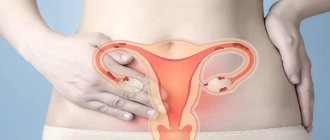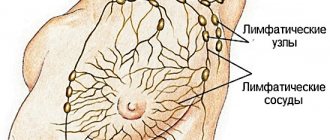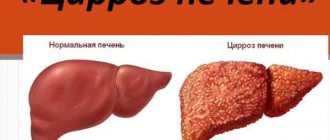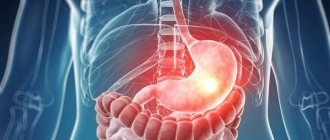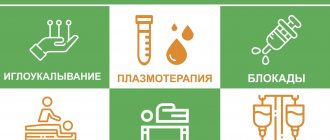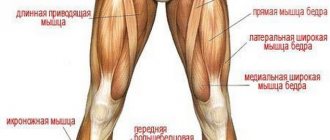Topographically, on the right side of the abdomen of the female body there is a fallopian tube, most of the intestines, the appendix, and the right ureter, which opens into the bladder. Typically, pain occurs as a result of the development of pathology in one of the above organs. However, discomfort can also arise due to physiological reasons.
Now let's look at this in more detail.
What to do if you have pain in the lower right abdomen?
In order to find out which organ of the female body provoked the occurrence of painful sensations in the right lower quadrant of the abdomen, the pain syndrome is detailed. This concept means an assessment of the severity and nature of pain (cramping, cutting, stabbing, pulling, etc.), as well as its relationship with body position, physical activity, urination and the act of defecation.
When conducting a diagnostic examination, the specialist must determine the presence of accompanying signs (fever, the nature of vaginal discharge, the presence of vomiting, diarrhea, etc.). At the same time, it is necessary to find out whether such pains appeared before and what caused them.
To make a final diagnosis, the patient is prescribed a diagnostic examination, which includes instrumental and laboratory methods.
It is mandatory for a woman to undergo an ultrasound of the pelvic organs, as well as blood and urine tests.
If a pathological process is suspected to be localized in the digestive or excretory system, it is recommended that the patient undergo an x-ray, as well as, if necessary, an endoscopic examination of the digestive organs, bladder or organs of the reproductive system.
Inflammation of appendicitis
Many people mistakenly believe that inflamed appendicitis can manifest itself as pain only on the right side.
This is truly a misconception, because this disease originates from the epigastric region.
Then the pain flows into the iliac region and into the lower back. The pain syndrome can cover the entire abdomen, especially the lower and right side.
At this time, accompanying symptoms may be observed. These are elevated body temperature, chills, nausea, and vomiting. The nature of the pain effect ranges from acute pain to aching and dull.
In the most acute cases, there is a cramping pain that hinders all the patient’s movements.
In this case, you should immediately call an ambulance, as the appendix may rupture and blood poisoning may occur.
Causes of pain in the lower right abdomen
In clinical practice, pain arising in the lower right quadrant is usually divided into 2 groups: gynecological and general (caused by diseases of other internal organs).
Causes of gynecological pain:
- Inflammatory diseases of the uterus and appendages.
- Ectopic (tubal) pregnancy.
- Torsion of the pedicle of the right ovarian cyst.
- Apoplexy of the right ovary (hemorrhage).
- The presence of a benign or malignant tumor on the right appendage of the uterus.
Causes of non-gynecological pain:
- Appendicitis (inflammation of the appendix).
- Inflammation of the lymph nodes of the intestinal mesentery (mazadenitis).
- Pathologies of the urinary tract.
- Intestinal diseases (Crohn's disease, neoplasms, diverticulosis).
Inflammation in the uterus and its appendages
Any disorders, inflammations and diseases that affect the uterus and its appendages in women are accompanied by unpleasant symptoms, including pain.
It is localized in the lower abdomen and can be on the left or right. The patient's condition worsens, weakness, dizziness and apathy appear. Nausea and loss of appetite may occur.
Among the ailments, such signs can provoke andexitis, uterine inflammation, salpingo-oophoritis and endometritis. The characteristics of pain can be varied and depend on the degree of damage.
There are both sharp and stabbing pain and aching pain. When palpating inflamed areas, pain may intensify.
In case of such violations, be sure to seek help from specialists. You should not delay your visit to the hospital, as this may cause serious complications.
Gynecological pain
In the case when a woman experiences pain in the lower right part of the abdomen, most often this condition can signal the presence of pathology in the uterine appendages. There are several factors by which one can suspect the development of a gynecological disease:
- The presence of acute or chronic inflammatory process in the uterine appendages;
- Menstrual irregularities;
- The occurrence of pathological vaginal discharge;
- Unfavorable medical history.
The nature of pain in acute gynecological pathology
In the case when pain in the lower right part of the abdomen develops suddenly and is characterized by the greatest degree of intensity, the patient requires urgent medical attention.
Symptoms of an acute abdomen can be provoked by ectopic pregnancy, acute inflammation of the appendages (adnexitis), hemorrhage into the ovary, torsion of the pedicle of an ovarian cyst. In this case, the pain is cramping, cutting or stabbing in nature.
When the fallopian tube ruptures, which is a consequence of tubal pregnancy, the so-called “dagger” pain occurs;
With an ovarian abscess or accumulation of gnosis in the fallopian tube, patients complain of sharp throbbing pain;
Often, pain caused by one or another gynecological problem radiates to the anus and the area of the sacroiliac joint;
With the development of massive bleeding, due to a drop in blood pressure, pallor of the skin and mucous membranes, dizziness, general weakness and increased heart rate are noted;
If a large amount of blood or pus enters the pelvic cavity, pain can radiate to the supra- and subclavian region, as well as to the right hypochondrium;
With the development of acute right-sided inflammation, along with pain in the lower abdomen, the patient’s body temperature rises and purulent vaginal discharge appears.
The nature of pain in chronic gynecological pathology
In the presence of a chronic inflammatory process in the right appendage, women complain of dull nagging pain localized in the lower right part of the abdomen. Often, painful symptoms are accompanied by the presence of mucopurulent discharge.
Under the influence of provoking factors (hypothermia, a stressful situation or physical overexertion, weakened immunity, etc.), there is a possibility of exacerbation of the pathological process, accompanied by the development of purulent complications. In the absence of adequate treatment, irreversible changes in the right appendage of the uterus may develop, which can lead to tubal infertility.
Pain in the lower right part of the abdomen during the development of neoplasms
In gynecological practice, there are often cases when the cause of pain localized in the lower right part of the abdomen is neoplastic processes (benign and malignant tumors on the ovaries or on the fallopian tube). As a rule, benign cystic neoplasms make themselves known once they reach a certain size (when the tumor begins to compress nearby tissues and organs).
When a malignant tumor forms on the fallopian tube, patients complain of pain in the right lower abdomen already in the early stages of its development. In this case, the painful sensations are cramping in nature and are often accompanied by copious watery discharge. Most often, this disease is detected in women who have reached 40-45 years of age and have entered menopause.
As for ovarian cancer, this pathology most often develops in the postmenopausal period, but for a long time it does not manifest itself in any way. In this situation, pain occurs against the background of symptoms of cancer intoxication and general exhaustion of the body, with the widespread prevalence of the tumor process. At the same time, there are often cases when pain in the lower right part of the abdomen with cancer of the right ovary makes itself felt in the very early stages of the disease. They arise for no reason, and have a short-term aching or pulling character.
Over time, pain occurs once every 4-5 days, lasts for 2-3 hours, and then subsides. In the case when the tumor grows into the pelvic cavity, the patient suffers from constant pain, which can change its character depending on the degree of damage to the organs and tissues involved in the pathological process.
Endometriosis
On the right side in women, aching pain in the lower abdomen is caused by endometriosis - the growth of cells of the uterine lining outside its boundaries.
© shutterstock
The disease is provoked by hormonal imbalances and disorders, due to which harmful lesions affect the lining of the uterus, which leads to bleeding between menstrual cycles, an inflammatory reaction, and scar adhesions.
Often this disease is diagnosed between the ages of 40 and 45, and the onset of endometriosis occurs during reproductive age. But every year the disease becomes younger, and sometimes occurs in teenage girls.
Unfortunately, to date, scientists have not been able to establish the exact cause of endometriosis. They were able to identify only a few theoretical reasons :
- Retrograde menstruation;
- Reduced immunity;
- Metaplasia;
- Müllerian duct;
- Genetic predisposition.
If treatment is not timely, the initial stage will develop into mild, then moderate and severe.
Signs of illness
During a disease such as endometriosis, the female sex feels:
- Pain in the right lower abdomen;
- Problematic periods;
- Abundant regulation;
- Pain in the hip joints;
- Dressed up sexual intercourse;
- Painful urination.
If a girl’s lower abdomen on the right hurts and the symptoms described above appear, it is imperative to go to the clinic to diagnose the disease and prescribe appropriate therapy.
Every woman should know that endometriosis can lead not only to unbearable pain in the right lower abdomen, but also to the appearance of cysts, menorrhagia, and infertility.
Treatment options
It is very difficult to diagnose endometriosis with a routine examination, so specialists send the patient for ultrasound, hysterosalpinography, and laparoscopy.
Not advanced stages of endometriosis are treated:
- Hormonal drugs;
- Antispasmodic medications;
- Anti-inflammatory drugs;
- Inhibitors;
- Acupuncture;
- Therapeutic exercises.
Statistics show that 12% of those affected by the disease require radical surgery - the removal of all female internal organs.
To avoid complications from pain in the right lower abdomen, it is advisable to seek advice from highly qualified doctors in a timely manner.
Pain in the right lower quadrant of the abdomen caused by acute appendicitis
In addition to gynecological diseases, inflammation of the appendix can provoke pain in the lower right part of the abdomen. In the absence of adequate medical care, this condition can cause suppuration and subsequent rupture of the appendix, which, in turn, provokes the development of peritonitis, and can even lead to death. Therefore, if the pain is concentrated in one point on the right, or is localized in the navel area, and does not go away for several hours, the woman needs urgent medical attention.
With inflammation of the appendix, a dull aching pain that occurs in the pit of the stomach slowly progresses and gradually moves to the iliac region. Very often, the pain radiates to the rectum and intensifies when walking, as well as when trying to roll over to the left side (in a lying position). Often, with the development of a pathological process, the patient experiences nausea, possible vomiting and increased body temperature.
Which doctor should I contact?
Pain on the right side of the abdomen can be caused by various diseases, the treatment of which is within the competence of different specialists. The choice of doctor should be made depending on the accompanying symptoms. If the pain is acute, does not subside over time, is accompanied by severe weakness, fever, a sharp deterioration in general health, a decrease in blood pressure or fainting, you must urgently call an ambulance. The patient is hospitalized in the hospital. The symptom complex indicates an acute emergency condition that can threaten not only the health, but also the life of a person. If help is not provided as soon as possible, there is a risk of death.
If the pain is moderate, you can visit a specialist as planned. First of all, you should consult a therapist. He will conduct an initial examination and perform diagnostics. Based on the information received, he can redirect the patient to other specialists
- Gastroenterologist - in addition to pain, the patient complains of constipation, bloating, flatulence, frequent bowel movements and soft feces, rumbling in the abdomen, nausea. Such symptoms indicate intestinal diseases.
- To the surgeon, the pain is nagging in nature and intensifies with stress, physical activity, sudden movements, but is in no way associated with digestive disorders, fever or general weakness. Such symptoms may indicate the appearance of adhesions in the abdominal cavity formed after surgery or inflammatory diseases of the digestive system.
- To the urologist - the pain radiates to the groin and lower back. It is combined with urination problems and forces a person to constantly move. The woman tries to find a position in which the pain will not be so severe. Symptoms indicate urolithiasis or renal colic.
- Neurologist - the pain is localized in the center and radiates to the right side of the abdomen. The unpleasant sensation is accompanied by frequent urination, which increases the pain. There is some blood in the urine. Symptoms indicate that the woman most likely has developed cystitis.
- For an infectious disease specialist - pain is combined with frequent initial loose stools, bloating, rumbling, lack of relief after defecation, and is accompanied by vomiting. The last symptom does not always occur. A set of signs indicates the development of an intestinal infection.
- To the gynecologist - the pain is dull or aching in nature. It occurs after stress, physical exertion or hypothermia. Most likely we are talking about inflammation of the uterine appendages. Associated symptoms include pain in the rectum, lower back or sacrum.
Unpleasant sensations also occur when urinating. The woman becomes hot-tempered and irritable. The menstrual cycle occurs irregularly. Fatigue increases. The discharge becomes greyish, greenish, yellowish, with flakes, pus or mucus. An increase in body temperature may occur.
A highly specialized specialist may prescribe additional diagnostic measures. Based on the results obtained, treatment is prescribed.
Other dangerous conditions that cause pain in the lower right abdomen
Acute surgical pain that occurs in the lower abdomen is called “acute abdomen” in clinical practice. This is a symptom complex characteristic of inflammation of the pancreas (acute pancreatitis) and peritonitis of various origins. The most characteristic signs of this pathological condition include unbearable pain, prevailing on the right, attacks of vomiting, significant deterioration in general condition, high body temperature. Such patients require urgent hospitalization in the surgical department.
Note: It is not recommended to take painkillers before a medical examination, as they can significantly change the clinical picture.
Mesadenitis
Sometimes, pain in the right lower abdomen is caused by mesadenitis. This disease causes inflammation of the lymph nodes. There are more than 500 of them in the human body. They perform a protective function, but when an infection gets into them, an inflammatory process occurs.
© shutterstock
Mesadenitis is divided into four forms, each of which causes aching, intensifying pain in the right lower abdomen:
- Acute;
- Chronic;
- Specific;
- Non-specific.
Often, the disease is diagnosed in children and adolescents.
Among the causes of mesadenitis are:
- Various viruses and bacteria;
- Mononucleosis;
- Burkitt's lymphoma;
- Nasopharyngeal carcinoma;
- Tuberculosis.
Signs of illness
The predominant signs of mesadenitis are pain in the right lower abdomen, which are similar to outbreaks of appendicitis. But sometimes the victim is unable to understand exactly where the pain occurs, since the disease affects the entire abdomen. In rare situations, the pain subsides, but this means that the lymph nodes have begun to fester. Such a process will lead to very unpleasant consequences and serious illnesses.
Among the associated symptoms are:
- Periodic nausea;
- One-time vomiting;
- Loss of interest in eating;
- Diarrhea;
- High temperature;
- Pressure changes;
- Accelerated heartbeat.
The chronic form is manifested by slightly noticeable pain in the right lower abdomen, which worsens after physical activity.
Treatment options
To cure pain in the right lower abdomen caused by mesadenitis, doctors prescribe:
- Antibiotics;
- Pain relieving drugs;
- Medicines that eliminate spasms;
- Anti-tuberculosis medications;
- Perinephric blocks;
- Solutions for detoxification of the body;
- Physiotherapeutic treatment;
- Calm, non-emotional rhythm of life;
- Diet.
By following all medical instructions, the disease will no longer cause pain in the right lower abdomen, and the patient will be able to quickly return to a full life.
Pain in the lower right quadrant caused by inflammatory pathologies
Painful sensations in the lower right side in women can be provoked by inflammatory bowel diseases such as ulcerative colitis (inflammation of the mucous membrane of the colon), granulomatous enteritis, or Crohn's disease (pathology of unknown etiology), ileitis (inflammation of the ileum), as well as helminthic infestations. At the same time, pain in the lower right part of the abdomen can cause compression of the nerve endings going to this area from the spine, occur due to herpes zoster (herpes virus infection) and the movement of a stone along the ureter.
Often, pain in the lower abdomen is caused by sexually transmitted diseases (gonorrhea, chlamydia, trichomoniasis). In this case, they are accompanied by purulent or mucopurulent vaginal discharge and discomfort during urination.
Ovarian apoplexy
This ovarian condition occurs as a result of follicle rupture during ovulation. At this time, the blood vessels in the ovary are damaged, which entails sharp pain on the right or left.
It all depends on which side the damaged ovary is located (on the right or left side). Hemorrhage occurs in the abdominal cavity. The reasons for this manifestation can be both physical activity and sexual intercourse.
If such a condition is accompanied by a decrease in blood pressure, weakness, dizziness, pallor of the face and skin, this is a serious reason to call emergency care, since this condition requires hospitalization, hospital treatment and the intervention of medical personnel and surgical care.
This disease carries very serious consequences that are very life-threatening.
Pain in the lower right abdomen during pregnancy
Physiological reasons
Most often, pain in the lower right quadrant of the abdomen in early pregnancy occurs due to the attachment of the fertilized egg to the right side of the uterus. However, pain can occur under the influence of progesterone, which relaxes and softens the tissues surrounding the uterus, and the growing uterus itself can also provoke pain.
Pathological causes
- Hypertonicity of the uterus (a condition that threatens miscarriage).
- Beginning of spontaneous abortion.
- Isthmic-cervical insufficiency (weakening of the internal os of the uterus).
- Precursor contractions.
- Cystitis.
- Digestive disorders.
If pain in the right lower abdomen becomes protracted, a woman should definitely consult a specialist who, after carrying out all the diagnostic examinations provided for in the protocol, will find out the cause of the pain and, if necessary, recommend adequate treatment.
After intercourse
If, upon completion of sexual intercourse, pain appears in the lower abdomen, tissue swelling may occur, accompanied by a rush of blood to the genitals due to sexual arousal.
This also includes injured tissues during intense sexual intercourse and diseases in the pelvis. These include adhesions, cancer, endometriosis, cervicitis, andexitis and endometritis.
Unpleasant sensations can cover the entire abdomen - right, lower and left.
At the first painful sensation in women, when the pain syndrome covers the abdomen, regardless of the location (right, lower or left area), immediately consult a doctor.
In many cases, this is a consequence of a developing disease, and sometimes its exacerbation. This is especially true for acute pain manifestations, when unbearable pain is felt, increasing and cramping.
If you ignore such signs, serious complications are possible, and sometimes life-threatening. Only a doctor is able to examine the body in detail and diagnose the disease.
After clarifying the diagnosis, the doctor will prescribe the correct treatment. Self-medication is dangerous both for health and for human life.
Tests to determine the disease
Since it is quite difficult to find out the causes of pain in the right side, it is advisable to perform diagnostic tests:
- Urine examination with culture and determination of susceptibility to antibiotics (the presence of bacteria, changes in the content of leukocytes or erythrocytes indicate pathological changes in the urinary system).
- A general blood test is required to determine inflammatory processes by changes in the amount of enzymes.
- Conducting an ultrasound examination of the internal organs of the pelvis to determine the presence of neoplasms, for example, tumors in the appendages.
- Diagnostic examination to determine if a woman is pregnant.
- Performing culdocentesis to determine the presence of fluid in the rectal and uterine area.
- Analysis of cervical mucus when there is a suspicion of an inflammatory process with drug sensitivity testing.
- Laparoscopy of the internal organs of the pelvis , to identify the most appropriate ways to manage the patient without extensive surgery.
- X-ray of the internal organs of the peritoneum , lying on the back, on the side and standing, to determine cyst ruptures, internal bleeding, intestinal obstruction, areas of calcification during stone formation in the kidneys and gall bladder.

